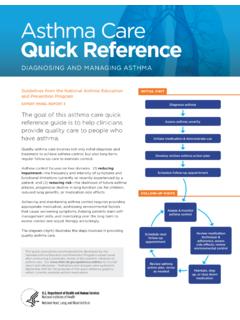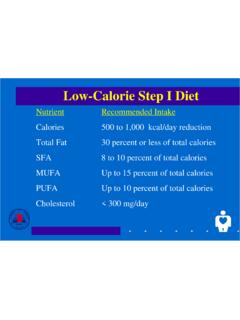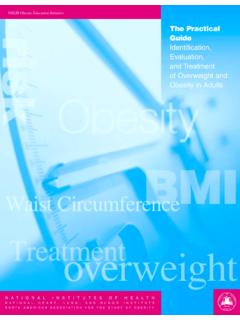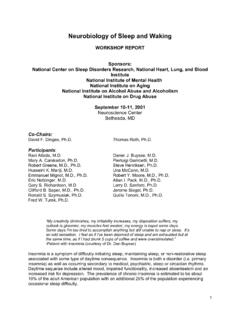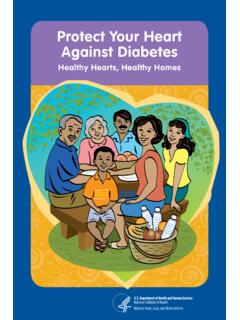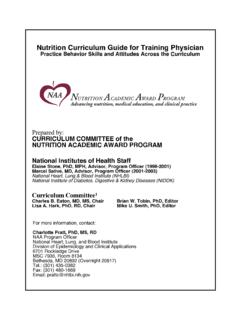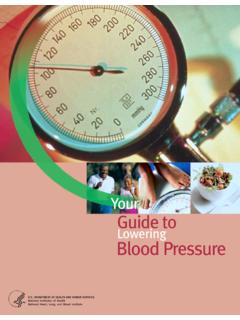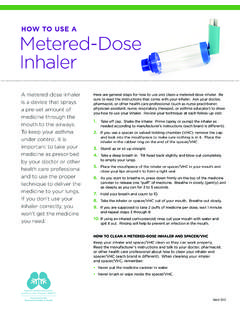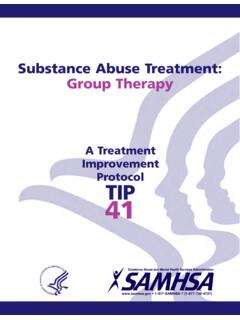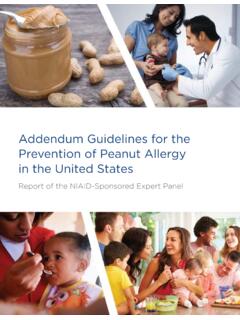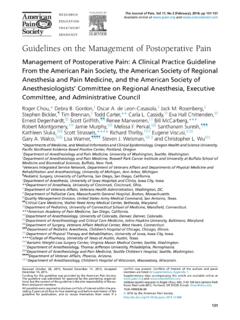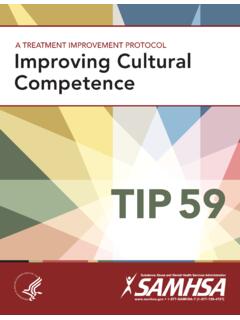Transcription of The Fourth Report on the Diagnosis, Evaluation, and ...
1 THE Fourth Report ON THE Diagnosis, Evaluation, andTreatment of High Blood Pressurein Children and DEPARTMENT OF HEALTH AND HUMAN SERVICESN ational Institutes of HealthNational Heart, Lung, and Blood InstituteTHE Fourth Report ON THE Diagnosis, Evaluation, andTreatment of High Blood Pressurein Children and DEPARTMENT OF HEALTH AND HUMAN SERVICESN ational Institutes of HealthNational Heart, Lung, and Blood InstituteNIH Publication No. 05-5267 Originally printed September 1996 (96-3790)Revised May 2005 THE Fourth Report ON THE DIAGNOSIS, EVALUATION, AND TREATMENT OF HIGHBLOOD PRESSURE INCHILDREN AND ADOLESCENTSCHAIRB onita Falkner, (Thomas JeffersonUniversity, Philadelphia, PA)MEMBERSS tephen R. Daniels, , (Cincinnati Children s Hospital MedicalCenter, Cincinnati, OH); Joseph T. Flynn, , (Montefiore Medical Center,Bronx, NY); Samuel Gidding, (DuPont Hospital for Children,Wilmington, DE); Lee A.
2 Green, , (University of Michigan, AnnArbor, MI); Julie R. Ingelfinger, (MassGeneral Hospital for Children,Boston, MA); Ronald M. Lauer, (University of Iowa, Iowa City, IA); Bruce Z. Morgenstern, (MayoClinic, Rochester, MN); Ronald , (The University of TexasHealth Science Center at Houston,Houston, TX); Ronald J. Prineas, , (Wake Forest University School of Medicine, Winston-Salem, NC); , (University of Michigan, Mott Children s Hospital, Ann Arbor,MI); Bernard Rosner, (HarvardSchool of Public Health, Boston, MA);Alan Robert Sinaiko, (University ofMinnesota Medical School, Minneapolis,MN); Nicolas Stettler, , (The Children s Hospital of Philadelphia,Philadelphia, PA); Elaine Urbina, (Cincinnati Children s Hospital MedicalCenter, Cincinnati, OH)NATIONAL INSTITUTES OFHEALTH STAFFE dward J.
3 Roccella, , (National Heart, Lung, and BloodInstitute, Bethesda, MD); Tracey Hoke, , (National Heart, Lung, andBlood Institute, Bethesda, MD); Carl , (National Center on SleepDisorders Research, National Heart,Lung, and Blood Institute, Bethesda,MD); Gail Pearson, , (National Heart, Lung, and BloodInstitute, Bethesda, MD)STAFFJ oanne Karimbakas, , , and Ann Horton, (American Institutesfor Research Health Program, SilverSpring, MD)FINANCIAL DISCLOSURESDr. Flynn has served as a consultant/advisor for Pfizer Inc., AstraZeneca LP,ESP-Pharma, and Novartis Pharmaceuticals;he received funding/grant support forresearch projects from Pfizer, AstraZeneca,and would like to thank the AmericanAcademy of Pediatrics for its help in dis-seminating this Report . We appreciate theassistance by: Carol Creech, ,Heather Banks, , and Angela Jehle(American Institutes for Research HealthProgram, Silver Spring, MD).
4 IiiAcknowledgmentsAcknowledgmentsTHE NATIONAL HIGH BLOODPRESSURE EDUCATIONPROGRAM COORDINATINGCOMMITTEE MEMBERORGANIZATIONSA merican academy of Family PhysiciansAmerican academy of Insurance MedicineAmerican academy of NeurologyAmerican academy of OphthalmologyAmerican academy of Physician AssistantsAmerican Association of Occupational Health NursesAmerican College of CardiologyAmerican College of Chest PhysiciansAmerican College of Occupational and Environmental MedicineAmerican College of Physicians American Society of Internal MedicineAmerican College of Preventive MedicineAmerican Dental AssociationAmerican Diabetes AssociationAmerican Dietetic AssociationAmerican Heart AssociationAmerican Hospital AssociationAmerican Medical AssociationAmerican Nurses AssociationAmerican Optometric AssociationAmerican Osteopathic AssociationAmerican Pharmaceutical AssociationAmerican Podiatric Medical AssociationAmerican Public Health AssociationAmerican Red CrossAmerican Society of Health-SystemPharmacistsAmerican Society of HypertensionAmerican Society of NephrologyAssociation of Black CardiologistsCitizens for Public Action on High Blood Pressure and Cholesterol, Education Foundation, Society on Hypertension in BlacksNational Black Nurses Association, Heart, Lung, and Blood InstituteAd Hoc Committee on Minority PopulationsNational Hypertension Association, Kidney Foundation, Medical AssociationNational Optometric AssociationNational Stroke AssociationSociety for Nutrition EducationThe Society of Geriatric CardiologyFederal Agencies.
5 Agency for Healthcare Research and QualityCenters for Medicare and Medicaid ServicesDepartment of Veterans AffairsHealth Resources and Services AdministrationNational Center for Health StatisticsNational Heart, Lung, and Blood InstituteNational Institute of Diabetes and Digestive and Kidney DiseasesivThe Fourth Report on the Diagnosis, Evaluation, and Treatment of High Blood Pressure in Children and AdolescentsvContentsContentsFOREWORD ..VIIINTRODUCTION ..1 METHODS ..3 DEFINITION OF HYPERTENSION ..4 MEASUREMENT OF BLOOD PRESSURE IN CHILDREN ..5 Ambulatory Blood Pressure Monitoring ..7 BLOOD PRESSURE TABLES ..8 Using the Blood Pressure Tables ..9 PRIMARY HYPERTENSION AND EVALUATION FOR COMORBIDITIES ..16 EVALUATION FOR SECONDARY HYPERTENSION ..18 Physical Examination ..18 Additional Diagnostic Studies for Hypertension.
6 19 Renin Profiling ..19 Evaluation for Possible Renovascular Hypertension ..19 Invasive Studies ..19 TARGET-ORGAN ABNORMALITIES IN CHILDHOOD HYPERTENSION ..22 Clinical Recommendation ..23 THERAPEUTIC LIFESTYLE CHANGES ..24 PHARMACOLOGIC THERAPY OF CHILDHOOD HYPERTENSION ..26 APPENDIX A. DEMOGRAPHIC DATA ..34 APPENDIX B. COMPUTATION OF BLOOD PRESSURE PERCENTILES FOR ARBITRARY SEX, AGE, AND HEIGHT ..36 SCHEME USED FOR CLASSIFICATION OF THE EVIDENCE ..39 REFERENCES ..40viThe Fourth Report on the Diagnosis, Evaluation, and Treatment of High Blood Pressure in Children and AdolescentsList of TablesTABLE Under Which Children <3 Years Old Should Have ..5 Blood Pressure Measured ..TABLE Dimensions for Blood Pressure Cuff Bladders ..6 TABLE Pressure Levels for Boys by Age and Height Percentile ..10 TABLE Pressure Levels for Girls by Age and Height Percentile.
7 12 TABLE of Hypertension in Children and Adolescents, ..14 With Measurement Frequency and Therapy Recommendations ..TABLE for Antihypertensive Drug Therapy in Children ..14 TABLE Evaluation of Confirmed Hypertension ..15 TABLE of Physical Examination Findings Suggestive ..20of Definable Hypertension ..TABLE Drugs for Outpatient Management ..28of Hypertension in Children 1 17 Years Old ..TABLE Drugs for Management of Severe Hypertension ..33in Children 1 17 Years Old ..TABLE A Data on Height/Blood Pressure Distribution Curves ..35by Study Population ..TABLE B Coefficients From Blood Pressure Regression Models ..38 List of FiguresFIGURE Algorithm ..32 This is the Fourth Report from the NationalHigh Blood Pressure Education Program(NHBPEP) Working Group on Children and Adolescents; it updates the previous pub-lication, Update on the Task Force Report (1987) on High Blood Pressure in Childrenand Adolescents ( ;98:649 58).
8 The purpose of this Report is to update clini-cians on the latest recommendationsconcerning the diagnosis, evaluation, andtreatment of hypertension in children; recom-mendations are based on English-language,peer-reviewed, scientific evidence (from 1997to 2004) and the consensus expert opinion ofthe NHBPEP Working Report includes new data from the1999 2000 National Health and NutritionExamination Survey (NHANES), as well asrevised blood pressure (BP) tables that includethe 50th, 90th, 95th, and 99th percentiles bysex, age, and height. Hypertension in childrenand adolescents continues to be defined assystolic BP (SBP) and/or diastolic BP (DBP)that is, on repeated measurement, at or abovethe 95th percentile for sex, age, and between the 90th and 95th percentile inchildhood is now termed prehypertension and is an indication for lifestyle guidelines are provided for the staging ofhypertension in children and adolescents, aswell as updated recommendations for diag-nostic evaluation of hypertensive addition, the Report evaluates the evidenceof early target-organ damage in children andadolescents with hypertension; provides therationale for early identification and treat-ment; and provides revised recommendations,based on recent studies, for the use of antihy-pertensive drug therapy.
9 Treatment recom-mendations also include updated evaluationof nonpharmacologic therapies to reduceadditional cardiovascular risk factors. Thereport describes how to identify hypertensivechildren who need additional evaluation forsleep disorders that may be associated withBP Bonita Falkner has our deep appreciationfor leading the members of the NHBPEPW orking Group in developing this new Falkner and the Working Group per-formed diligently and brilliantly to assemblethis document in a timely manner. Applyingthese recommendations to clinical practice willaddress the important public health issue ofimproving inadequate BP M. Alving, DirectorNational Heart, Lung, and Blood InstituteandChairNational High Blood Pressure Education ProgramCoordinating CommitteeviiForewordForeword1 IntroductionIntroductionConsiderable advances have been made indetection, evaluation, and management ofhigh blood pressure, or hypertension, in chil-dren and adolescents.
10 Because of thedevelopment of a large national database on normative blood pressure (BP) levelsthroughout childhood, the ability to identifychildren who have abnormally elevated BPhas improved. On the basis of developing evidence, it is now apparent that primaryhypertension is detectable in the young andoccurs commonly. The long-term health risksfor hypertensive children and adolescents canbe substantial; therefore, it is important thatclinical measures be taken to reduce theserisks and optimize health purpose of this Report is to update clini-cians on the latest scientific evidenceregarding BP in children and to provide rec-ommendations for diagnosis, evaluation, andtreatment of hypertension based on availableevidence and consensus expert opinion of theWorking Group when evidence was publication is the Fourth Report from theNational High Blood Pressure EducationProgram (NHBPEP) Working Group onChildren and Adolescents and updates theprevious 1996 publication, Update on theTask Force Report (1987) on High BloodPressure in Children and Report includes the following information.
